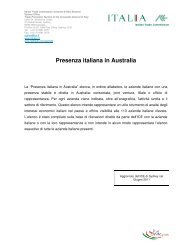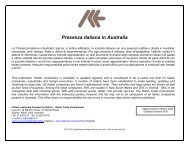Price Determination in the Australian Food Industry A Report
Price Determination in the Australian Food Industry A Report
Price Determination in the Australian Food Industry A Report
You also want an ePaper? Increase the reach of your titles
YUMPU automatically turns print PDFs into web optimized ePapers that Google loves.
FROZEN PROCESSED VEGETABLES – ANALYSIS OF PRICING<br />
Background<br />
Australia has a small frozen vegetable process<strong>in</strong>g sector that services <strong>the</strong> products markets <strong>in</strong><br />
frozen peas, beans and potato products.<br />
The green vegetable sector is based <strong>in</strong> Tasmania, which has a low-cost production environment <strong>in</strong><br />
a very reliable climate without water and heat issues which affect yield and quality, and a reliable<br />
skills base <strong>in</strong> grow<strong>in</strong>g.<br />
Grower contracts<br />
The supply of vegetables to processors for use <strong>in</strong> processed beans, peas and potatoes is made<br />
under supply contracts with processors. Suppliers are contracted to supply <strong>in</strong> certa<strong>in</strong> time<br />
w<strong>in</strong>dows. Overall production is managed by <strong>the</strong> processor to ma<strong>in</strong>ta<strong>in</strong> a supply profile that is <strong>in</strong><br />
l<strong>in</strong>e with <strong>the</strong> needs of <strong>the</strong> bus<strong>in</strong>ess.<br />
The contracts specify area, tim<strong>in</strong>g, yield performance, product specifications, price and terms. The<br />
contracts carry strict penalties for variation from specification to avoid wastage or poor yields<br />
through process<strong>in</strong>g.<br />
The major challenge fac<strong>in</strong>g producers <strong>in</strong> <strong>the</strong> regions supply<strong>in</strong>g <strong>the</strong> vegetable processors has been<br />
<strong>the</strong> lack of price <strong>in</strong>crease over time despite <strong>the</strong> perceived ga<strong>in</strong>s <strong>in</strong> <strong>the</strong> end price of <strong>the</strong> products.<br />
There are high cost barriers to entry <strong>in</strong> <strong>the</strong> game – ga<strong>in</strong><strong>in</strong>g access to land, technology, equipment<br />
and a contract. Limited land availability is ano<strong>the</strong>r restriction.<br />
Processors of <strong>the</strong>se products have <strong>in</strong>vested substantially <strong>in</strong> automation of process<strong>in</strong>g to reduce<br />
<strong>the</strong> costs and <strong>in</strong>crease yields.<br />
The approach taken<br />
The only available data on <strong>the</strong> analysis of farmgate and retail prices <strong>in</strong> <strong>the</strong> processed frozen sector<br />
is that which compares <strong>the</strong> products on an equivalent basis <strong>in</strong> a snapshot approach.<br />
O<strong>the</strong>r than <strong>the</strong> reported retail prices for frozen products from <strong>the</strong> retail sector, <strong>the</strong>re is little<br />
transparency <strong>in</strong> <strong>the</strong> <strong>in</strong>formation at wholesale and farmgate levels. While <strong>the</strong>re is a time series of<br />
data at retail level for frozen peas (shown below), no such analysis exists for potato products.<br />
Anecdotal retail data is available <strong>in</strong> this regard.<br />
In <strong>the</strong> case of peas, an imputed estimated average farmgate cost per kg of product has been used.<br />
Figure 71. Retail prices for frozen peas, cents/kg, 1993–2003<br />
cents<br />
350<br />
300<br />
250<br />
200<br />
150<br />
100<br />
50<br />
0<br />
Source: <strong>Industry</strong> sources and ABS<br />
retail<br />
1993 2003<br />
farm<br />
<strong>Price</strong> competition for domestically produced peas and beans comes <strong>in</strong> <strong>the</strong> form of imported<br />
product which is generally sold under private label, though imported brands. This ma<strong>in</strong>ta<strong>in</strong>s tight<br />
pressure on <strong>the</strong> scope for price <strong>in</strong>creases to <strong>the</strong> processor, though <strong>the</strong> extent of marg<strong>in</strong> pressure is<br />
unclear.<br />
<strong>Price</strong> <strong>Determ<strong>in</strong>ation</strong> <strong>in</strong> <strong>the</strong> <strong>Australian</strong> <strong>Food</strong> <strong>Industry</strong> A <strong>Report</strong><br />
69







